Physical Address
304 North Cardinal St.
Dorchester Center, MA 02124
Imaging is important in the diagnosis and management of orthopedic disorders and sports-related injuries. Athletic injuries are common among all age groups. Patients are becoming more knowledgeable with respect to their injuries and the imaging modalities available to diagnose them. Meanwhile, physicians have become more adept at combining their clinical skills with imaging findings to affect better patient care. Subspecialization in the fields of sports medicine and musculoskeletal imaging provides a higher level of clinical service for patients and their primary health care providers. All of these factors have contributed to an increase in utilization of imaging.
Physicians must be aware that the imaging workup for clinical problems can often take a number of routes, ultimately leading to the correct diagnosis. In many instances there is no single “right or wrong” imaging algorithm. A number of factors should be taken into account in planning the optimal imaging strategy for a given clinical problem with respect to variable patient demographics. These factors include the desire to avoid ionizing radiation from computed tomography (CT) and scintigraphy in younger patients, regional geographic variations in the accessibility to magnetic resonance imaging (MRI), the relatively high costs of MRI and scintigraphy, and the availability of local expertise in musculoskeletal sonography. These factors must be balanced against the likelihood of establishing a diagnosis with various investigational imaging modalities in order to determine the optimal course of imaging.
In this chapter, basic imaging techniques are reviewed, encompassing radiography (including fluoroscopy and arthrography), ultrasonography, CT, nuclear medicine, and MRI. Technical concepts related to each modality are outlined, particularly with regard to variables that affect image quality. An overview of the advantages and disadvantages unique to each modality is also provided. Arthrography, fluoroscopy, and orthopedic interventional procedures are briefly discussed. An overview of radiation doses associated with common diagnostic procedures is presented.
In 1895, Wilhelm Konrad Röntgen discovered the x-ray, which ultimately led to the field of medical imaging. In 1901, Röntgen received the Nobel Prize in physics for his discovery of the x-ray.
X-rays are a form of ionizing radiation composed of short-wavelength electromagnetic photons with variable penetration through different tissues in the body. A wire filament in an x-ray tube generates an electron beam that bombards a tungsten target, resulting in a stream of x-ray photons directed toward the patient. Upon reaching the patient, x-rays can be absorbed or scattered within the patient, or they may pass through the patient. The x-rays that pass through the patient strike x-ray–sensitive material positioned behind the patient ( Fig. 7.1 ). Film-based radiographs have largely been supplanted by digital radiography in modern centers during the past two decades. In digital radiography, the x-rays that are transmitted through the area of interest interact with a digital detector system positioned behind the patient to create a radiographic image. The primary benefit of digital radiography is to implement a complete digital picture archiving and communication system (PACS) where images are stored digitally and are readily available through computer networks.
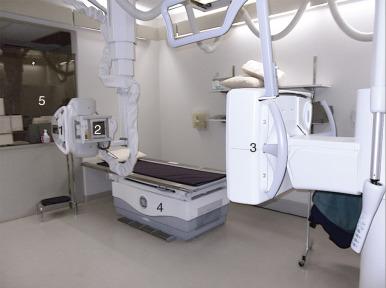
Two types of digital detector systems are currently available—computed radiography (CR) and direct radiography (DR)—each with its own advantages and disadvantages. Both systems are currently required to provide a full complement of digital radiographic images in modern medical imaging facilities. CR systems can be integrated into older film-based radiographic equipment at a substantial cost savings compared with installation of a DR flat panel system, which comes with a high capital cost. CR technology utilizes a storage-phosphor image plate, which replaces film in older systems and requires a separate laser scanner readout step. DR systems convert x-rays into images through a direct readout process built into a detector unit, eliminating a separate image-processing step and resulting in the immediate production of an image. The need for a separate readout step in CR is similar to processing film in older systems and is inefficient, with relatively reduced patient throughput compared with DR systems. Furthermore, the use of cassettes in CR systems can lead to work-related chronic repetitive strain injuries in technologists. Work-related strain injuries are less common in DR systems because cassettes are not used. Current DR technology cannot be used for most portable radiographs and certain specialized views, such as an axillary projection of the shoulder or a skyline view of the patella. In these instances CR must be used, although DR capability in this area is currently in evolution. A greater dynamic range may be obtained with both systems, potentially reducing the amount of radiation to which patients are exposed.
Several factors contribute to the optimization of radiographic images. Proper positioning of the patient and elimination of motion is essential. Optimal exposure of the film prior to the advent of digital imaging used to be crucial; however, greater latitude is now permitted in the range of exposure values while remaining diagnostic, because the brightness and contrast of an image can be manipulated and optimized at the physician's workstation. Exposure is controlled by altering the number and/or energy of the incident x-ray photons. The number of incident photons is determined by the strength of the current used to generate the electron beam, abbreviated as mA-s (milliampere-second). The energy of the x-ray photons is related to the strength of the voltage potential, abbreviated as kVp (kilovoltage potential), through which the electrons are accelerated before striking the tungsten target. Once x-rays are formed, their individual energy cannot be modified. However, filters that provide differential absorption can modify the quality of the x-ray beam. These filters function to remove low-energy x-rays that typically are randomly scattered within the patient and never reach the film, contributing to patient dose and not to image formation. As a general rule, thicker and denser structures generally require both a higher energy and a greater of quantity of x-ray photons for a diagnostic image. The converse is true for thinner and less dense anatomic locations.
Variable transmission of the x-ray photons through tissues of different composition results in the classic radiographic densities of bone, water/soft tissue, fat, and gas ( Fig. 7.2 ).
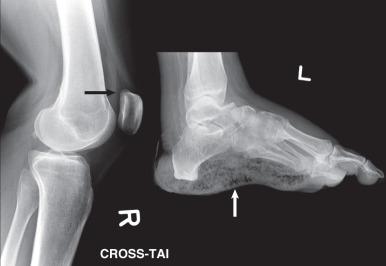
Fluoroscopy is a special type of x-ray technology that produces rapid images, thus allowing real-time visualization of structures. It is an essential tool for both the radiologist and the orthopedic surgeon. In fluoroscopy, x-rays penetrate the patient and are transformed into light photons upon striking a fluoroscopic screen. The fluoroscopic screen is coupled to an image intensifier and video camera, and the images are displayed on a monitor ( Fig. 7.3 ). Image intensifiers are currently being replaced by flat-panel detector technology with improved spatial resolution and higher absorptive capability, potentially resulting in a dose reduction to the patient. A single static image mode or a rapid series of images in a video mode using frame rates of 30 to 35 images per second can be generated. The spatial resolution of fluoroscopic images is inferior to that of radiographs because less radiation is used to form the image.
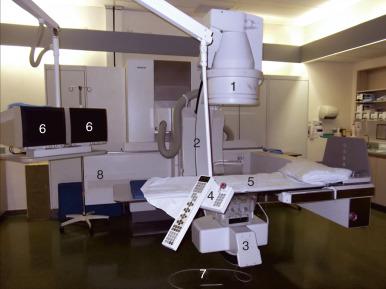
Radiologists often use fluoroscopy for needle guidance in musculoskeletal procedures such as arthrography, arthrocentesis, and administration of medication ( Fig. 7.4 ). Non–image-guided joint injections and interventional spine procedures have failure rates up to 30%, even in large joints such as the shoulder. Orthopedic surgeons routinely use intraoperative fluoroscopy for a variety of surgical procedures ranging from fracture reduction and fixation to joint replacement surgery. Video fluoroscopy can also play a role in the dynamic assessment of joints to evaluate them for instability.
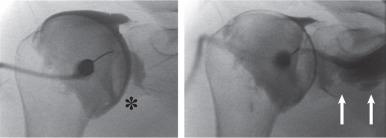
Intraoperative fluoroscopy also assists orthopedic surgeons while performing total knee arthroplasties (TKAs) by allowing for precision of alignment in the coronal plane, using only a mean fluoroscopy time of 3 seconds. Patients operated on using this new technique had a lower risk of malalignment and a lower exposure to radiation, compared with the conventional technique.
Different techniques to reduce radiation using intraoperative fluoroscopy have recently been studied. Double C-arm fluoroscopy, a technique using two C-arms instead of the conventional single C-arm, allows for assessment of screw placement in three dimensions and has a burgeoning role in the treatment of intertrochanteric fractures with intramedullary nails. This has been shown to significantly reduce surgical times and intraoperative radiation exposure. In addition, different sizes of C-arms have been investigated in an effort to reduce radiation exposure to surgeons with studies indicating that mini C-arms may increase dosimeter absorption.
Arthrographic procedures involve placing a fine-gauge needle (20 or 22 gauge) into a joint under fluoroscopic or ultrasound imaging guidance. These procedures are minimally invasive and relatively short in duration and are generally well tolerated by patients. Arthrography is often required for administration of medication such as steroids, local anesthetics, and viscose supplements, along with intraarticular contrast material for magnetic resonance (MR) and CT arthrography. In MR arthrography, a very dilute (1/200) mixture of gadolinium with saline solution and/or iodinated contrast media is injected into the joint before MRI is performed ( Fig. 7.5 ). Use of a mixture of iodinated contrast material to dilute the gadolinium allows for continuous monitoring during the arthrographic procedure and provides the ability to switch to a CT arthrogram if the MRI is unsuccessful because of claustrophobia. In CT arthrography, an iodinated contrast agent is injected to produce a single-contrast CT arthrogram ( Fig. 7.6 ). Intraarticular air can be added after the iodinated contrast material is administered to produce a double-contrast CT arthrogram, although single-contrast studies are often preferred. A small amount of epinephrine may be added to the injectate to constrict synovial vessels and prolong resorption of the contrast material. The arthrogram must be coordinated with the booking of the CT or MR appointment, which should be scheduled so that imaging is carried out within 30 to 45 minutes after the injection, because rapid systemic absorption of contrast material through the synovium starts immediately after the joint injection. Given the logistics of trying to coordinate fluoroscopy and MR appointment bookings, MR and CT arthrographic examinations are more challenging to schedule. Patients may have longer wait times for the appointment compared with noncontrast studies, with the wait averaging up to 6 months in some institutions where MR resources are more limited per capita. Joints that typically are imaged with MR and CT arthrography examinations include the shoulder, hip, wrist, ankle, and knee. It is advisable to avoid the abbreviations MRA or CTA when requesting CT or MR arthrographic examinations because confusion with the request for an MR or CT angiogram may occur; the latter procedure corresponds to a completely different imaging technique in which intravenous contrast is administered to visualize vascular structures.
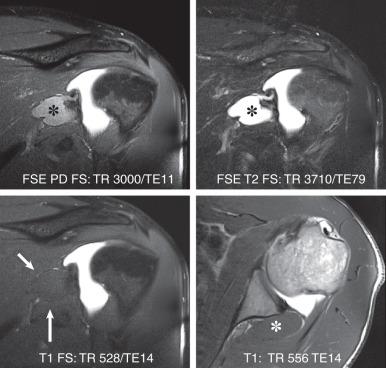
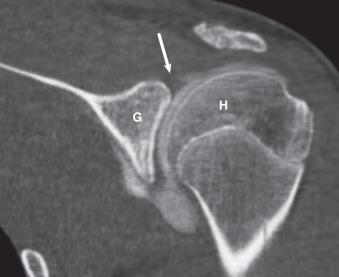
Diagnostic arthrography is helpful in pinpointing the source of nonspecific periarticular symptoms in patients. This technique involves the injection of both short- and long-acting local anesthetics after establishing the intraarticular position of the needle with radiographic contrast material. The response of the patient's pain to the initial injection of anesthetic is documented immediately after the procedure, and the patient is then given a pain diary to monitor the effectiveness of the anesthetic for several hours after the procedure.
Arthrography is associated with small risks, the most significant of which is sepsis. Sepsis is reported to occur in less than 1 in 2000 cases. Allergy to intraarticular contrast media is extremely rare compared with intravenously administered contrast media but can occur as a result of the slow systemic absorption of contrast material from the joint; the incidence of an allergic reaction is greatest in patients who have a known significant previous allergic reaction to contrast material, such as anaphylaxis. In patients with a history of a significant previous reaction to contrast material, alternative imaging or investigations should be sought. In patients who take anticoagulants, reversal is often required prior to the procedure to reduce the risk of bleeding. Pregnancy is a relative contraindication to fluoroscopy, although the radiation dose is minimal. These small risks should be carefully considered and balanced with the added information gained from arthrography compared with alternative noncontrast imaging options.
MR arthrography is generally preferred over CT arthrography because of the relatively higher diagnostic quality of the MR images, which is related to superior contrast discrimination and lack of ionizing radiation. CT arthrography images are often less optimal compared with MR arthrography images, particularly in the hip and shoulder joints, because of relatively thick surrounding soft tissues. These thick tissues cause scatter of the CT x-rays, resulting in increased noise and overall image degradation. However, CT arthrography is an alternative option in patients who cannot undergo MR examinations because of claustrophobia or the presence of other MR-incompatible material.
CT arthrography also has added utility compared with MRI in the diagnosis of evaluation full thickness osteochondral lesions, specifically in the ankle. Only half of full thickness cartilage lesions found on CT arthrography were detected on MRI. Early detection of these lesions is especially important, as they may predispose patients to osteoarthritis. In addition, the evaluation of osteochondral defects is not only important in the preoperative but also the postoperative phase. Many of these patients have metallic hardware, which CT arthrography does a better job of suppressing. CT arthrography is also better than MRI in the detection of subchondral cysts or fissural defects which allow communication between intraarticular synovial fluid and cysts. This knowledge aids the surgeon in deciding whether to take an antegrade or retrograde approach.
The diagnostic utility of CT arthrography is also optimal compared with MR arthrography in the evaluation of hyaline cartilage lesions within the shoulder. Although CT arthrography is superior in the evaluation of shoulder cartilage, MR arthrography is excellent in evaluating labral tears and bony Bankart lesions; however, caution should be taken in the evaluation of glenohumeral ligament and rotator cuff tendon injury, as it is not as sensitive as conventional arthroscopy in the evaluation of these structures. The position of the shoulder also influences the utility of MR arthrography, as studies have shown indirect MR arthrography of the shoulder in the abduction, external rotation view has a higher sensitivity in the detection of partial and full-thickness tears of the supraspinatus tendon when compared with the neutral shoulder position.
Evaluation of partial/degenerative ligamentum teres tears of the hip is also aided by MR arthrogram, where it has better capability of detecting tears compared with conventional MRI. Limitations of conventional MRI in patients with chronic rotator cuff tears are likely secondary to fibrotic changes, simulating intact tendon.
Radiographs provide the basis for the initial evaluation of virtually all bone and joint pathology. They are essential in the diagnosis of bone and joint trauma because they provide a high degree of specificity in the setting of acute trauma. Plain radiographs are a valuable utility in the preoperative phase for bone pathology, while using a fraction of the radiation compared with CT. Radiographs are inexpensive and widely available, and recent studies have demonstrated they continue to provide clinical utility with a dose reduction of radiation without sacrificing radiographic details.
The projectional nature of radiographs can lead to underdiagnosis of dislocations and fractures, especially when fractures are minimally displaced, incomplete, or in a complex anatomic area. Fractures or dislocations identified on a single view may be difficult to appreciate on a second view. A minimum of two orthogonal views are required for assessment of underlying pathology ( Fig. 7.7 ). When there is a high degree of clinical suspicion for a fracture in the setting of normal radiographs, options for further workup include follow-up radiographs or additional imaging with CT, MR, or scintigraphy. False-negative radiographs are also common in the setting of early stages of osteolytic pathology, which is commonly associated with osteomyelitis and neoplastic pathology. At least 30% to 50% of the diameter of the bone must be destroyed to perceive underlying pathology ( Fig. 7.8 ). With the exception of calcified or ossified lesions, abnormalities of the soft tissues are not well demonstrated on radiographs because muscle, tendons, ligaments, fluid, and most soft tissue masses have a similar density. MRI and ultrasound are more optimal for demonstrating soft tissue pathology.
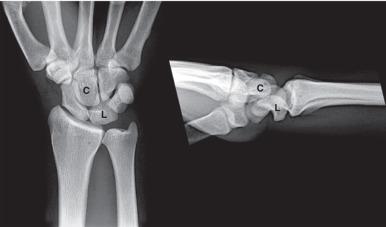
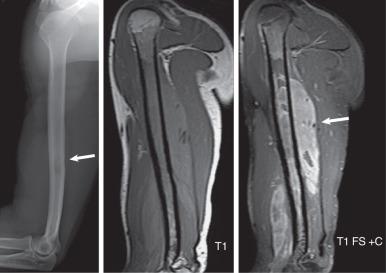
The use of ultrasound in the evaluation of the musculoskeletal system has increased substantially during the past 20 years and provides an important adjunct to the repertoire of imaging modalities. Ultrasound is often used as a first-line investigation in the evaluation of tendon, muscle, and ligament injuries and soft tissue masses.
Ultrasound images are created by transmitting high-frequency sound waves above the audible range of human hearing into the body. The key component of the imaging system is the transducer, or probe, which is connected by a cable to a computer and an image screen. The technology is based on the piezoelectric physics principle in which a specialized piezoelectric transducer crystal can convert an electrical signal into a sound wave or vice versa. The piezoelectric transducer crystal, which is housed in an ultrasound probe, vibrates when an electrical current is applied to it and emits sound waves. The sound waves interact with the body tissues. Some of the sound waves are reflected back toward the transducer at soft tissue interfaces that have significantly different impedances, whereas other sound waves are refracted or absorbed. The reflected sound waves are detected by the transducer, amplified, and subsequently converted back into an electric signal that is processed by the computer to generate a digital image.
When the ultrasound probe is placed on the skin overlying the area of interest, the sound waves are directed into the soft tissues located immediately beneath the probe, allowing visualization of structures encountering the sound waves. Manipulation of the ultrasound probe by the operator at the bedside determines how the structure of interest is viewed. For example, when imaging a tendon, the long axis of the probe is aligned parallel to the long axis of the tendon to produce a long axis view of the tendon. By turning the transducer 90 degrees perpendicular to the long axis of the tendon, a true short-axis view of the tendon is obtained. Slight rocking movements of the transducer from side to side provide further visualization of the medial-lateral or cranial-caudal extent of the structure of interest. If the structure of interest is larger than the footprint of the probe, the entire probe is repositioned over the area that was not previously imaged to view the additional area. Depending on how the transducer is angled, an infinite number of image planes can be obtained; however, standard axes include long-axis/sagittal and short-axis/transverse views, depending on the orientation of the structure of interest. During scanning, a rapid continuous series of images is generated, producing the appearance of a movie, termed real-time imaging. Typically, individual representative images are captured and stored as part of the examination record; however, video images or a series of images can be stored in a movie loop and occasionally are obtained to give other personnel the opportunity to view relevant aspects of the study after the examination is completed. It should be emphasized that no other imaging modality is more reliant on the operator performing the study at the bedside than is the case with sonography because this is where all of the pathology is initially observed during real time and documented. If the bedside operator cannot distinguish between normal and pathologic findings or does not scan the abnormal area, the examination will not document the underlying pathology. It also should be understood that the individual images stored to document the examination reflect a tiny, hopefully representative portion of the entire examination, which is akin to reviewing a few photographs compared with watching an entire movie.
A variety of configurations of ultrasound probes are available for musculoskeletal imaging with different contact surfaces or footprints, including linear and curved array configurations ( Fig. 7.9 ). Linear array probes are most commonly used for evaluation of the musculoskeletal system. The sound waves are emitted from the probe in a parallel fashion, which is optimal for imaging the linear internal architecture of tendons, ligaments, and muscles. A water-based coupling gel is applied over the area to be scanned to improve the contact between the ultrasound probe and skin to facilitate sound transmission. The frequency of the sound waves used for evaluation of the musculoskeletal system is generally in the 10- to 15-MHz range. The transducer frequency is directly proportional to image resolution, with high-frequency transducers providing exquisite architectural detail of soft tissue structures. Unfortunately, the higher frequency transducers come with a penalty, because the depth of sound penetration is inversely proportional to the frequency. Thus the highest frequency transducers are only able to image very superficial structures a few centimeters deep to the skin.

Ultrasound machines are equipped with several operator-controlled features that allow optimization of the image quality ( Fig. 7.10 ). A depth control adjusts the amount of tissue imaged up to a maximum of several centimeters, determined by the frequency of the transducer. The focal zone should be adjusted to the area of concern to enhance resolution and simultaneously optimize the frame rate. The overall gain controls the signal amplification of the returning sound waves to either increase or decrease the desired level of brightness of the image. A Doppler mode can be applied, which uses the Doppler effect of moving blood to assess for the presence of blood flow in tissues. Both color and power color Doppler options, which are available on most machines, provide information on tissue vascularity. Color Doppler signal reflects the mean frequency shift of moving blood cells, providing information on velocity and direction of blood flow ( Fig. 7.11 ). The direction of blood flow is encoded as either a red or blue color, depending on whether the blood flow is toward or away from the transducer. Power Doppler shows the total power of the Doppler shift, without regard for direction of flow or flow velocity, and is very sensitive to flow. The optimal Doppler mode for showing tissue vascularity in musculoskeletal sonography is controversial and likely related to individual features that are unique to the manufacturer. Recently many hospital-based imaging departments have introduced intravenously administered ultrasound contrast agents that serve as an alternative for selected patients who are not suitable candidates for use of contrast agents with MRI or CT; experience with the use of these contrast agents in musculoskeletal ultrasound applications is limited to date.
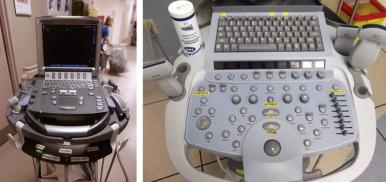
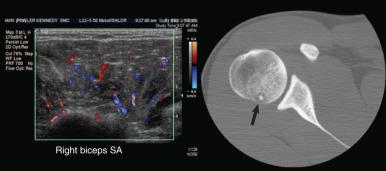
The interaction of the sound waves at soft tissue interfaces determines the appearance of a structure on the ultrasound image. In areas where a significant difference in acoustic impedance exists, all of the sound waves are reflected back to the transducer, creating an area of increased echogenicity or hyperechoic focus. Because most of the sound waves are reflected back to the transducer, few sound waves travel further into the soft tissues deep to the reflective surface, producing an artifact manifested by focal loss of echogenicity, termed acoustic shadowing ( Fig. 7.12 ). An example of this phenomenon occurs at soft tissue–bone or calcium interfaces. In areas where there are no soft tissue interfaces, no sound waves are reflected back to the transducer, as occurs with simple fluid collections. In this setting, the fluid appears black, or anechoic, often with transmission of more sound waves posterior to the structure, creating an artifact termed increased through transmission. Three criteria must be met to confirm the diagnosis of a simple fluid collection on ultrasound, including lack of internal echoes (i.e., anechoic), a well-defined posterior wall, and increased through transmission of the sound waves ( Fig. 7.13 ). Soft tissue interfaces with similar interfaces and acoustic impedances show a similar degree of echogenicity and are termed isoechoic ( Fig. 7.14 ).
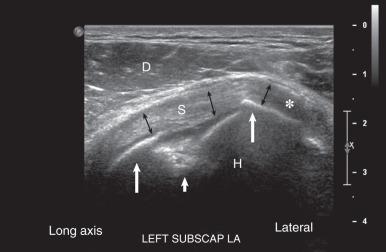
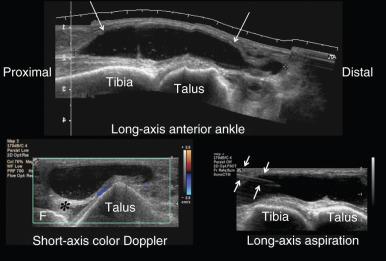
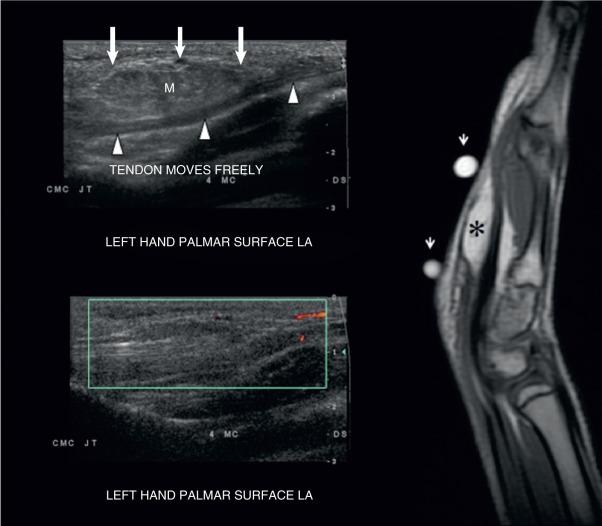
The high resolution afforded by sonography enables the detailed internal architecture of tendons, superficial ligaments, and muscle tissue to be accurately assessed. Normal tendons appear as linear hyperechoic fibrillar structures in their long axis ( Fig. 7.15 ). Tendinosis or microtearing typically manifests, as varying degrees of loss of the normal fibrillar pattern of the tendon replaced by hypoechoic areas and may become increased/hypertrophic or decreased/atrophic in thickness. Frank tendon tears manifest as focal areas of discontinuity of tendon fibers (see Figs. 7.15 and 7.16 ). While scanning tendons, it is imperative to align the ultrasound transducer perpendicular to the long axis of the structure of interest to prevent anisotropic artifact. Anisotropy is the artifactual apparent decrease in echogenicity in a structure when the angle of insonation relative to the structure of interest is off the 90-degree perpendicular axis, potentially resulting in the misdiagnosis of tendinosis or tear ( Fig. 7.17 ). Anisotropy is most problematic in anatomic areas where the structure of interest has a curved geometry, such as the insertion of the tendons of the rotator cuff (see Fig. 7.12 ). It also can affect the echogenicity of ligaments and muscles. Sonography has played a long-established role in the diagnosis of rotator cuff tears and has proven to be as accurate as noncontrast MRI (see Fig. 7.17 ). Ligaments are typically thin hyperechoic structures that become thickened and hypoechoic or discontinuous when torn. Muscle tissue is hypoechoic, with fine linear areas of increased echogenicity corresponding to fibro-fatty perimysium surrounding the muscle fascicles (see Fig. 7.12 ). Subcutaneous fat, which is hypoechoic, contains small echogenic septations. Articular cartilage is near anechoic. Fibrocartilaginous structures such as the glenoid, meniscus, and acetabular labra are hyperechoic. Nerves appear as fascicular structures with variable echogenicity, depending on adjacent structures ( Fig. 7.18 ). Assessment of large peripheral nerves is feasible with sonography and more efficient than MR, because a greater length of the nerves can be scanned without any restriction in coverage created by a local coil in MR.
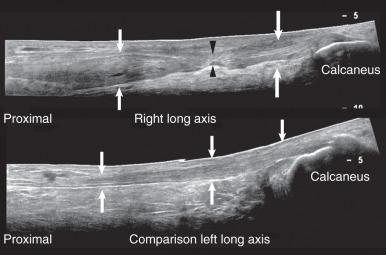
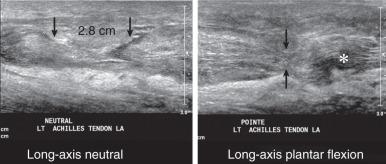
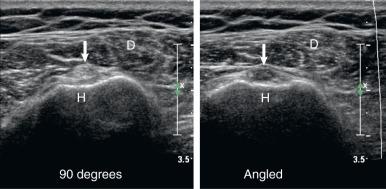
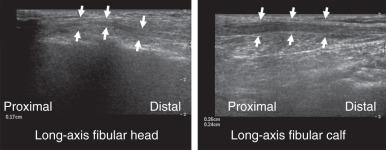
Ultrasound also frequently serves as a first line of investigation in the evaluation of soft tissue masses. Sonography can be used to confirm the presence of a clinically suspected lesion and at times can establish a definitive diagnosis. Ultrasound enables the differentiation of simple fluid-containing masses such as ganglia, bursae, and synovial cysts from solid lesions, eliminating the need for further imaging with MRI (see Fig. 7.13 ). However, differentiation of complex cystic fluid collections that contain proteinaceous or hemorrhagic fluid from solid masses is not always feasible with ultrasound ( Figs. 7.19–7.21 ). The diagnosis of a solid lesion is established when internal vascularity is demonstrated within a lesion with color Doppler imaging. However, occasionally solid hypovascular lesions may not reveal flow with Doppler imaging, because the signal from slow flow may be below the threshold sensitivity of the ultrasound probe (see Fig. 7.14 ). Detection of soft tissue calcifications associated with calcific tendinopathy, ossificans, and some tumors on ultrasound is superior to radiography, CT, and MR ( Fig. 7.22 ).
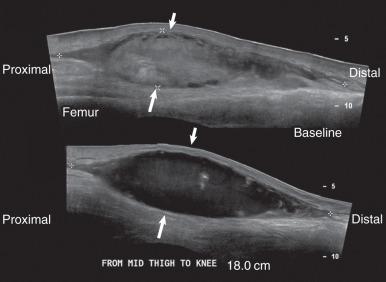
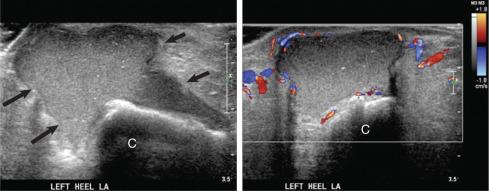
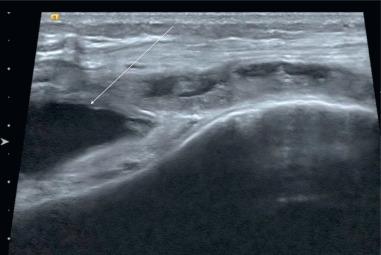
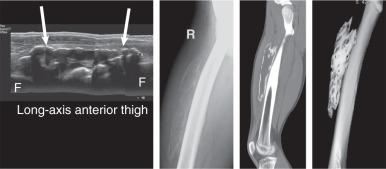
Sonography can be used to guide interventional procedures, including biopsy of soft tissue masses, diagnostic and therapeutic aspiration of joint effusions and periarticular fluid collections, aspiration and lavage (barbotage) of calcium deposits for treatment of calcific tendinosis, and injection of a local anesthetic and steroids for diagnosis and therapy. In general, sonographic-guided procedures are more technically demanding than fluoroscopic procedures, because fewer radiologists have the expertise and training to perform the procedures. Sonography is an alternative to fluoroscopic-guided arthrography, which often is reserved for patients who have contrast allergies or to reduce radiation exposure in young patients. The individual preference of the radiologist, the age of the patient, and the length of the waiting list for the appointment (if applicable) often determine whether sonographic or fluoroscopic guidance is preferred. Consultation with the radiologist performing such procedures is suggested. Ultrasound also plays an occasional role in foreign body localization. Although metal and glass can usually be identified on radiographs, wood is infrequently detected because its attenuation is similar to that of soft tissues. Ultrasound enables detection of all three materials, confirming the presence of the foreign body and providing guidance to aid removal of the object.
Ultrasound elastography is a relatively new technology, which primarily assesses the mechanical properties of tissue, such as tendons, ligaments, and muscles. There are multiple techniques to perform sonographic evaluation of the mechanical properties of tissues; however, the most common way is free hand strain (compression) elastography. Compression elastography is performed by manually applying stress with a handheld ultrasound probe, which in turn results in the displacement of soft tissues with varying tensile strengths. Based on these color-coded distribution maps, elastograms are created, which measure the elasticity of soft tissues relative to one another ( Fig. 7.23 ).
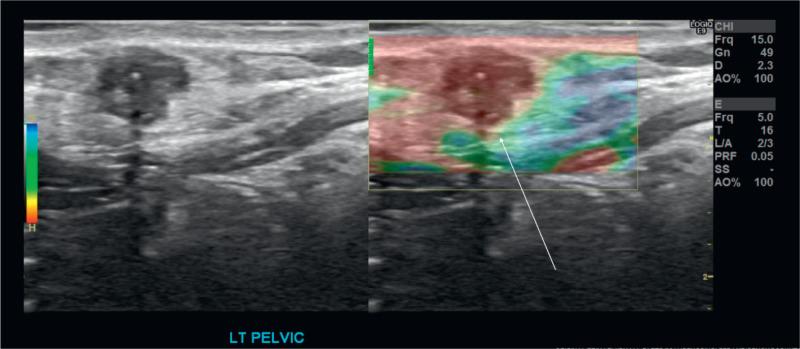
In sports medicine, sonographic elastography evaluation primarily focuses on the Achilles tendon and is able to quantify the elasticity value. It is based upon the hypothesis that mechanical stress upon soft tissues causes its appearance to change on sonographic evaluation. This principle is best used to examine degenerative and traumatic changes and has added utility in the ability to monitor the effectiveness of physical therapy on healthy and diseased musculotendinous tissue.
Sonographic elastography of the Achilles tendon is most effective in the evaluation of Achilles tendinopathy by detecting alterations in tendon tensile strength, particularly in those with areas of softening. Future applications of elastography are aimed toward identifying patellar tendinopathy and rotator cuff tendinopathy.
Ultrasound elastography also has a burgeoning role in rehabilitation of musculoskeletal injury and chronic myofascial pain, by measuring the mechanical properties of tissue, including muscle stiffness. It has also been found to assist in certain pain syndromes such as iliotibial syndrome, particularly in stretching prior to exercise.
Dynamic ultrasound has proven to be of great utility in the evaluation of abnormalities of the ligamentous, tendinous, and muscular structures that can only be identified in a dynamic evaluation. Dynamic evaluation of the rotator cuff tendons can be of utility when determining the severity of shoulder impingement syndrome, specifically when there is moderate to severe impingement. In moderate impingement, there will be prominence of the subacromial/subdeltoid bursa or fluid lateral to the acromion process. In severe impingement, the humeral head migrates and the supraspinatus tendon will appear to be more prominent, as it is not able to glide smoothly underneath the acromial-acoustic shadow. In addition, ulnar neuropathies, which may otherwise go undetected using conventional ultrasound methods, may be better appreciated on dynamic ultrasound imaging, as the nerve enters the cubital tunnel ( Fig. 7.24 ).
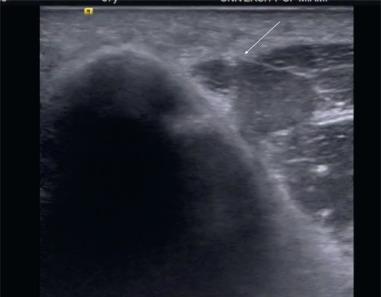
In addition, dislocation/subluxation of the long head of the biceps tendon may sometimes be transient and sit within the bicipital groove while the shoulder is in the neutral position. In these circumstances, dislocation/subluxation can only be identified on dynamic maneuver and external rotation will elicit the abnormality. The long head of the biceps tendon can dislocate anterior or deep in relation to the subscapularis tendon.
Subluxation of the peroneus brevis and longus tendons can also be assessed using dynamic sonography. Diagnosis may be difficult to make using physical examination, and MRI may not reveal tendons that are transiently dislocated. This applies to tendons in the foot as well, as placing the foot in dorsiflexion and eversion of the ankle will reveal lateral displacement/dislocation of the perineal tendons in relation to the fibula.
In addition, subtle muscle tears may also only become apparent on dynamic sonographic evaluation. These tears may appear as areas of echogenic infiltration, a heterogeneous mass, or focal disruption of muscle fibers. These findings are also frequently accompanied by perifascial fluid. Dynamic sonography is also appropriate in the discrimination of a pseudo mass caused by a muscle tear, as during isometric muscle contraction the torn muscle appears as a focal bulge.
Within the wrist, dynamic ultrasound provides a fairly rapid and cost-effective evaluation of the intrinsic and extrinsic ligaments. Dynamic ultrasound has also proven to be effective in the evaluation of rotator cuff injury, particularly in the evaluation of full-thickness tears. The diagnostic accuracy of shoulder ultrasound in the evaluation of partial and full thickness rotator cuff tears reaches approximately 91% to 100%.
Sonography has numerous advantages compared with other imaging modalities. Unlike radiography and CT, which subject the patient to small risks associated with the use of ionizing radiation, ultrasound has no known deleterious effects. Because ultrasound equipment is relatively inexpensive, the technology is widely available. Portable ultrasound equipment is commercially available, enabling immediate on-site point of care evaluation. Ultrasound images have relatively high spatial resolution compared with MR images. Dynamic evaluation of the musculoskeletal system is possible with sonography, unlike with MR and CT, with which only limited assessment is possible. Vascular information from Doppler interrogation is available on virtually all ultrasound machines with the push of a button, unlike CT and some vascular pulse sequences in MRI that require the use of intravenous contrast material, subjecting patients to the small risk of an allergic reaction and adding to the cost of the examination.
Ultrasound has the added capability of adding reliability in diagnosis of cam-type femoroacetabular impingement (FAI) and can serve as an alternative or additional method in initial imaging. New studies have demonstrated ultrasound also has an added benefit in the trauma setting in regard to contributing to the workup of acute coracoclavicular ligament injury, as well as providing valuable information in regard to fracture healing.
Although musculoskeletal sonography is used widely in European and Canadian institutions, acceptance has been slow in many centers in the United States. Limitations include a relatively long learning curve and a high degree of operator dependence compared with other imaging modalities. To provide consistent and reliable results, technologists and physicians involved in musculoskeletal sonography should receive proper training. The contact area or “footprint” of the ultrasound probe restricts the volume of tissue interrogated at any single site during the examination to a small area constrained to several centimeters, which makes it challenging for clinicians to grasp a complete perspective of the pathology, particularly when assessing large, soft tissue structures. Extended and dual-image/split-screen modes allow a larger area of tissue to be captured in a static image with a standard probe to alleviate this issue, and these options are currently available on most machines. These large field of view images are obtained when either the technologist or physician overseeing the study decides it would help illustrate the abnormality to provide a clearer understanding of the pathology ( Fig. 7.25 ). Because bone reflects sound waves, evaluation of osseous structures is limited to their topography. The quality of ultrasound images is affected by the patient's body habitus, with poorer quality images in large patients because of the absorption of the sound waves. The challenge of assessing deep-seated anatomic regions is another limitation; because of the absorption of sound waves, lower frequency transducers are required to gain depth penetration, with a consequent reduction in spatial resolution. Musculoskeletal ultrasound typically is performed as a focused evaluation in an anatomic region or of a specific structure and is generally not performed as a survey technique, unlike CT and MRI.
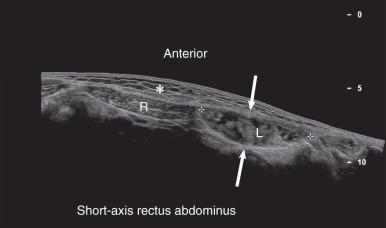
CT has revolutionized medical imaging since its introduction as a clinical tool in 1974. Sir Godfrey Hounsfield received a Nobel Prize in 1979 for his contribution to the development of this technology. The original generation of scanners had extremely limited capacity to assess the musculoskeletal system; they were composed of single-detector configurations with longer acquisition times and low-resolution limited diagnostic quality image reformats. Since the introduction of spiral scanners in 1989 and multidetector scanners in 1992, CT has become an integral tool in the evaluation of the musculoskeletal system. Multidetector CT scanners have evolved rapidly from the earliest four-channel units to the latest generation commercially available 160-channel scanners.
CT is a tomographic technique that takes advantage of x-ray interaction with tissues in the body, similar to radiography. The technology differs from radiography in that the x-ray source and opposing detector array are housed in a gantry that rotates circumferentially around the patient. The patient is positioned supine on a moving table inside the opening in the gantry. The x-ray tube emits a narrow x-ray beam continuously during the circumferential rotation that passes through the patient and is received by the detector. The detector measures differences in x-ray absorption (attenuation) as the beam rotates around the patient, and the x-ray signal is then back-computed mathematically (using a Fourier transform), resulting in the creation of a raw projectional data set.
Early conventional CT images were acquired using a “step and shoot” technique in which a single slice was obtained with the patient lying on the CT table, which was incrementally moved a short distance. The second slice was acquired and the process was repeated many times, until the anatomic area of interest was imaged. This technique required a large amount of time for image acquisition and had the potential for significant image degradation due to motion artifact.
Advances in CT engineering led to continuous spiral (helical) CT technology. In spiral CT, the x-ray tube and detector rotate continuously with the patient lying on the scanner table, which simultaneously moves through the gantry, resulting in a significant reduction in imaging time. Further technical developments led to multislice technology, in which multiple detectors formed in an array are used to acquire multiple slices with each rapid rotation of the gantry. The latest generation CT scanners have up to 160 detector arrays, which are capable of acquiring up to 160 slices with each 360-degree rotation of the tube. Multislice scanners have resulted in very fast acquisition times and ultrathin collimation, resulting in exquisitely detailed anatomic images, thus enabling reformatting in any plane with excellent resolution. Electron-beam CT scanners were introduced in the mid-1980s and use a different technique to obtain even faster imaging. In this technology, the x-ray tube is stationary and an electron beam is electronically swept around the patient. This technology has been developed primarily for imaging cardiac and other moving structures.
Each pixel of the CT image is assigned a Hounsfield unit (HU) value that reflects the attenuation of the x-ray beam. The attenuation values are potentially useful in characterizing tissues and can be measured by placing a region of interest cursor over the area in question. The density of water is set at 0 HU, and air is set at −1000 HU. The density of soft tissue typically ranges between 10 and 90 HU. Medullary bone ranges between 30 and 230 HU, and cortical bone typically measures between 230 and 1000 HU. Less dense tissues such as fat have a lower attenuation value of around −80 HU. Similar to radiography, dense tissues appear bright/white and less dense tissues appear dark/black. A grayscale map corresponding to the HU value assigned to each pixel is applied, with the resultant CT image display reflecting underlying tissue composition. The image can be manipulated by selecting the range of HUs in which the grayscale map is applied, termed window width , and selecting the value that should be assigned to the middle of the grayscale map, termed window level . For optimal visualization of osseous structures, a bone window is used, consisting of a high window width of 1000 to 2000 HU and a window level of approximately 250 HU. For optimal soft tissue contrast, termed a soft tissue window , a narrower window width of 400 to 600 HU is used, with a window level of about 50 HU ( Fig. 7.26 ). The window width and window levels can be adjusted at the PACs computer workstation using the x- and y-axes of the computer mouse. Both bone and soft tissue windows should be reviewed to provide a complete assessment of the images. Occasionally a hematoma or an incidental but clinically significant visceral neoplasm is detected on the soft tissue windows.
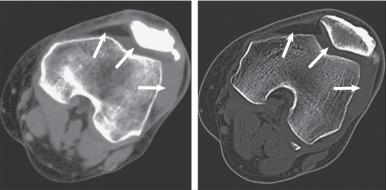
If information regarding vascular structures is required in the setting of trauma, an iodinated intravenous contrast agent can be administered, with the scanning timed to reflect the desired vascular phase (arterial or venous). Contraindications to the use of an iodinated intravenous contrast agent include renal failure and a previous allergic reaction to iodinated contrast media.
All multidetector CT scanners produce a preliminary raw projection data set in the transverse plane that is routinely converted into a volumetric data set of thin 0.625-mm transverse sections for musculoskeletal applications. Special reconstruction kernels (computer algorithms) are applied to the raw data set prior to generating reformatted images that optimize the structure of interest. In musculoskeletal imaging, these options include bone, soft tissue, and metal algorithms ( Fig. 7.27 ).
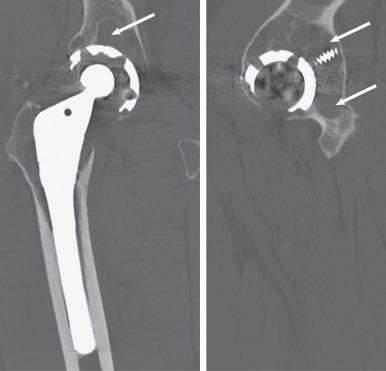
The transverse volumetric thin-slice data set is postprocessed in a variety of ways and typically is carried out at a separate workstation as part of an automated program or is processed manually by a technologist or radiologist. The generation of large sets of more than a thousand postprocessed images and the subsequent transmission of the images to PACs adds to the time required to complete the examination. For musculoskeletal applications, thin-slice multiplanar reformats are typically routinely reconstructed in the sagittal and coronal planes. Selected additional reformats are obtained when they are deemed to be contributory by the radiologist or if they are specifically requested by the referring physician. Curved multiplanar reformats are useful in anatomic areas with curved geometry such as the clavicle, carpus, and tarsus. Additional three-dimensional (3D) postprocessing options include surface and volume rendered images ( Fig. 7.28 ); 3D surface rendering produces grayscale images based on the surface anatomy, whereas 3D volume rendering generates images using the entire data set, including deeper anatomy, with a full color range where useful. 3D rendering is routinely used in musculoskeletal imaging and provides a global overview of pathology. Segmentation is another postprocessing technique, whereby certain structures in the image can be cropped out, allowing a selective display of only the structure of interest. Segmentation is most useful in the setting of intraarticular fractures in which the articular surface of the affected bone is displayed in isolation to eliminate overlapping structures ( Fig. 7.29 ).
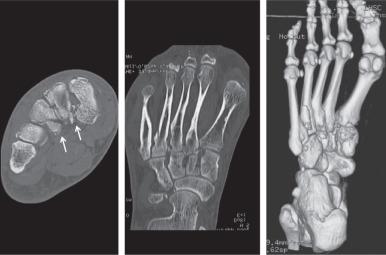
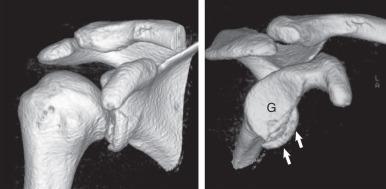
CT arthrography is a technique in which a CT scan is obtained after the intraarticular administration of radiographic contrast. This technique has lower inherent soft tissue discrimination and has largely been supplanted by noncontrast MR or contrast MR arthrography; however, it occasionally is warranted in patients who have contraindications to MRI ( Fig. 7.30 ).
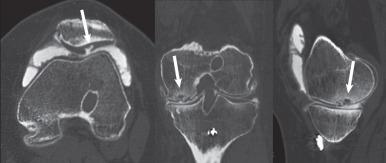
CT-guided biopsies are typically performed in lesions that are confined to bone. If a soft tissue mass is present in association with a bone lesion, ultrasound-guided biopsy is typically the preferred route because it is more efficient and prevents interruption of the workflow on CT. On some units, CT fluoroscopy is an option for guiding biopsies, but currently it is not widely utilized because of concerns regarding the high radiation dose delivered to both the patient and the radiologist.
CT images have superb spatial resolution that is typically greater than that of MR images. Multidetector array machines facilitate ultrafast imaging, generating total body scans in several seconds; thus they reduce the potential for motion artifacts and eliminate the need for sedation in pediatric patients. High-resolution image reformats can be produced in multiple planes with use of a variety of postprocessing options from a single transverse data set.
CT serves as an adjunct to conventional radiographs in the evaluation of skeletal trauma; it provides a more detailed and diagnostically sensitive examination, which helps determine appropriate clinical management. CT plays an essential role in the diagnosis of radiographically occult fractures and in the evaluation of comminuted and/or intraarticular fractures, particularly in anatomically complex regions ( Figs. 7.31 and 7.32 ). Although MRI is the modality of choice in the evaluation of bone tumors, CT is used for problem solving in selected instances when cortical integrity is questioned and for the definitive assessment of matrix mineralization. CT is often used to guide percutaneous biopsy of bone lesions when ultrasound guidance is not feasible ( Fig. 7.33 ). In postoperative patients, CT can be used to assess arthroplasty or other hardware-related complications, along with bone graft and fracture healing (see Fig. 7.27 ).
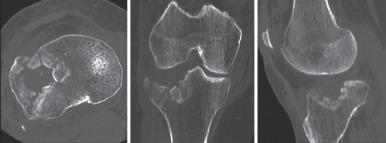
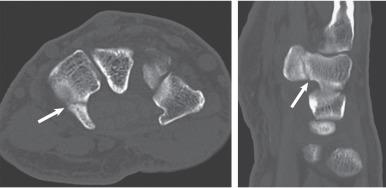
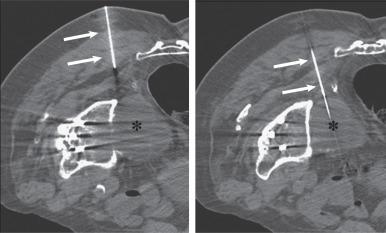
Shortcomings of CT are mainly related to the radiation dose received by the patient, which occurs to the greatest extent in parts of the body where the soft tissues are thickest, particularly in the spine, pelvis, and chest, resulting in exposure of radiosensitive gonadal and breast tissue. The peripheral extremities are not subjected to the same risks as the proximal extremities because the radiosensitive organs are outside of the field of scattered x-rays. Thus alternate imaging strategies should be considered when feasible in young patients, particularly when radiosensitive tissues are included in the scanning range.
Soft tissue contrast discrimination in CT is inferior compared with MRI, although limited assessment of larger soft tissue structures such as muscles, tendons, and some ligaments can be obtained ( Fig. 7.34 ).
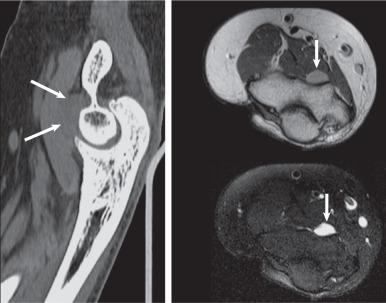
Nuclear medicine examinations involve the use of radioactive substances administered to patients. These studies are a common clinical tool in use since the 1950s. This modality has evolved considerably with respect to the number and variety of agents available for use and also in the development of hybrid imaging technologies, with the latter incorporating concurrent anatomic and morphologic information from CT and more recently MR. Nuclear medicine differs from other imaging modalities in that it provides information primarily related to disease processes based on cellular function and physiology, with limited inherent spatial resolution and anatomic information.
Unlike radiographs and CT examinations that depend on x-ray photons generated from a source external to the patient, nuclear medicine studies involve the administration of radioisotopes to patients. These radioisotopes then concentrate in the patient and emit gamma radiation, which is captured by an external camera. Radioisotopes are tagged to specific chemical substances (or ligands), forming radiopharmaceutical agents that target certain biologic processes in the body. Radiopharmaceutical agents are frequently administered intravenously, but they also may be given orally or subdermally, or they may be inhaled in different types of scans. Nuclear medicine provides images reflecting areas of clinical concern shown by areas of accumulation of radiotracer as a result of increased blood flow in the setting of inflammation, injury, and some neoplastic pathologies.
Scintigraphic images may be obtained in a planar or tomographic fashion ( Fig. 7.35 ). In planar imaging, the images are displayed in a similar fashion as radiographs, with all data superimposed along the length of the image. Tomographic techniques, termed single photon emission computed tomography (SPECT), involve a 360-degree rotation of the gamma camera followed by multiplanar image reconstructions in the transverse, sagittal, and coronal planes similar to CT, leading to improved anatomic localization and diagnostic sensitivity. SPECT images take longer to acquire than planar images, and as a result are more sensitive to patient motion.
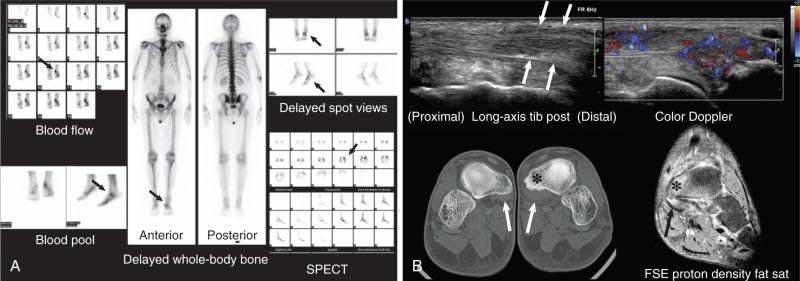
A major advance in the field of nuclear medicine during the past decade has been the development of hybrid technology combining SPECT with CT, termed SPECT/CT , which provides even greater spatial resolution and diagnostic specificity. SPECT/CT equipment incorporates variable resolution CT scanners, typically in the range of 4 to 16 detector units. Depending on the need for simple anatomic localization or higher resolution images for detailed morphologic assessment of the underlying pathology, the CT is programmed to adjust the radiation dose for either a low dose or standard scan , respectively ( Fig. 7.36 ).
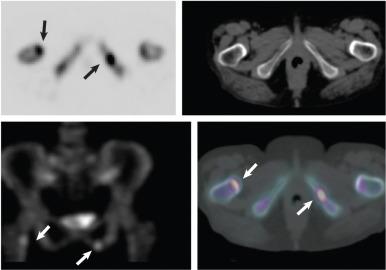
Skeletal scintigraphic examinations, also termed bone scans , are an invaluable tool in the assessment of musculoskeletal conditions. These studies involve the intravenous administration of bone-seeking analogues of calcium, phosphate, or hydroxyl groups tagged to technetium-99. The ligands most commonly used for tagging technetium are phosphate analogues in the form of biphosphonate compounds such as methylene or hydroxymethylene diphosphonate. The biologic half-life of technetium diphosphonates is 24 hours. The radiopharmaceutical agents are incorporated into bone as hydroxyapatite crystals in inorganic matrix during the process of bone turnover.
Because bone is a very dynamic tissue, incorporation of the radiotracer occurs rapidly, often 15 to 30 minutes after it is injected. However, unincorporated radiotracer within the soft tissues must be cleared systemically through the urinary tract prior to imaging to eliminate the potential for overlying artifact. Prolonged soft tissue clearance causing increased background soft tissue uptake occurs in patients with impaired renal function, potentially reducing the diagnostic quality of the examination. To facilitate clearing of the isotope from the background soft tissues, patients are instructed to drink plenty of fluids after the injection, with imaging typically performed 2 to 4 hours after the injection.
Both MRI and labeled white blood cell scans are highly sensitive and specific in the diagnosis of osteomyelitis and are reported in the range of 75% to 100% and 80% to 90%, respectively. The diagnosis of osteomyelitis and soft tissue infection can be established using autologous leukocytes labeled with either technetium-99m hexamethylpropylene amine oxine or indium-111 oxine. White blood cell scans are generally performed in conjunction with a triple-phase bone scan to distinguish cellulitis from osteomyelitis and aid in the interpretation. When necessary, a sulfur colloid bone marrow scan also may be required as part of the investigation. The total radiation dose for this type of study is relatively high, which is related to the additive dose from the initial bone scan, the white blood cell scan, and the sulfur colloid scan when it is also is performed, although the dose from the latter scan is relatively small.
White blood cell uptake is not specific for infection and occurs in any condition associated with an inflammatory response. Labeled white blood cell scans are a two-staged examination. The first component of the study takes approximately 1 to 2 hours and involves the withdrawal of blood from the patient, labeling of the white blood cells with the radioisotope, and injection of the cells back into the patient. The labeled leukocytes migrate to sites of inflammation and to areas of normal hematopoietic marrow in the axial and central appendicular skeleton. Technetium-labeled white blood cells are then imaged within 1 to 2 hours after injection, whereas indium-labeled white blood cells usually require a delay of approximately 24 hours. Spot views and SPECT reconstructions are often obtained as part of these examinations.
White blood cell scans rely on the presence of the radiolabeled functional white blood cells migrating to areas of inflammation as a result of infection. In the appropriate clinical context, an area of focally increased activity more intense than that of normal marrow activity indicates infection ( Fig. 7.37 ). White blood cell scans are less sensitive in the assessment of chronic infections.
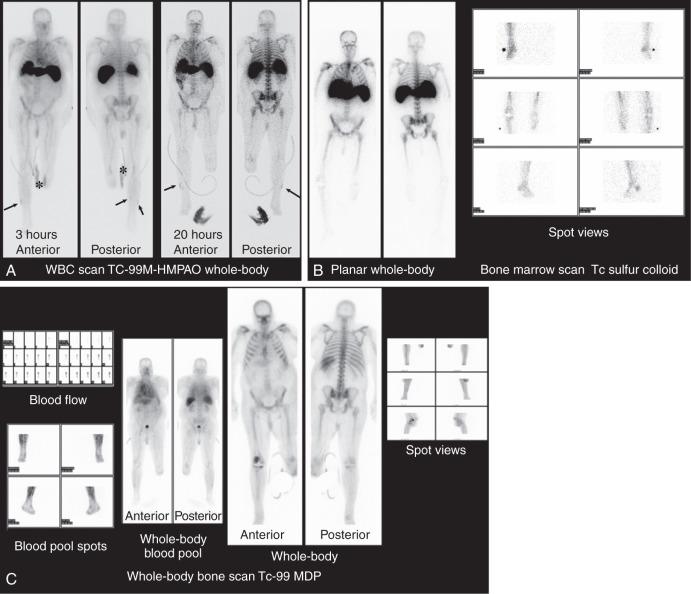
Become a Clinical Tree membership for Full access and enjoy Unlimited articles
If you are a member. Log in here